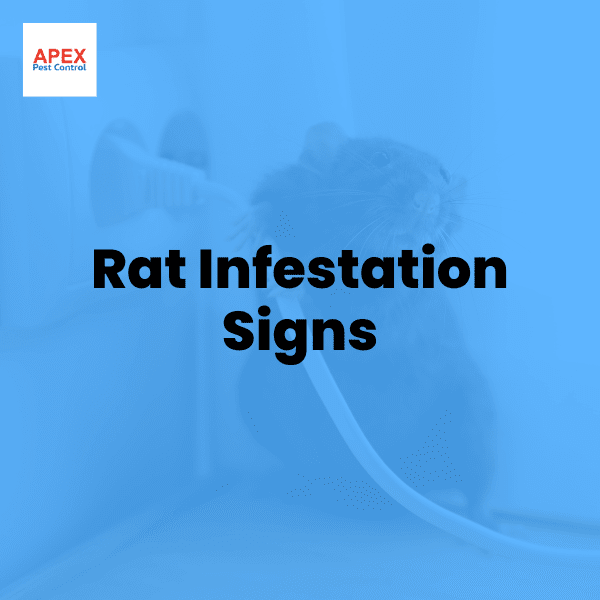Rat Infestation: Key Signs And Effective Solutions
At Apex Pest Control, we understand the importance of early detection when it comes to rat infestations. Our expert team has compiled this comprehensive guide to help you recognise the signs of rat presence and take prompt action to protect your home and health.
Discover our in-depth resource on Common Rat Diseases, detailing the health risks associated with rodent infestations and providing essential information for protecting yourself and your family from these serious threats.
Recognising Rat Infestation Signs
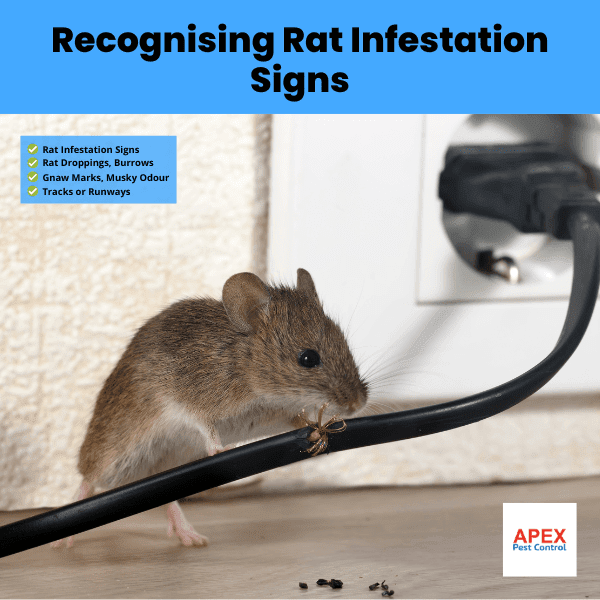
Physical Signs
Rat Droppings
One of the most obvious signs of a rat infestation is finding their droppings. These small, dark pellets are often found in places where food is stored, such as kitchens and pantries. Fresh rat droppings are shiny black, oval-shaped, and can be up to ¾ of an inch long. You may find up to 40 droppings per night in areas where rats feed or nest.
Gnaw Marks
Rats have strong teeth that can chew through almost anything. If you notice gnaw marks on furniture, walls, wiring, or rubber materials, it’s likely there are rats present. These gnaw marks are easily identifiable and can cause significant damage to your property.
Tracks or Runways
Look for tracks or runways – these are routes used by rats between food sources and nests. They usually follow walls and may be visible as smudgy lines or worn down paths. You might also notice rub marks along baseboards or walls, caused by the oils and dirt in rat fur as they move along established routes.
Burrows
Some types of rats burrow into the ground creating complex tunnel systems. Look for holes in your garden, especially near compost heaps or piles of wood. These rat holes are typically 2-4 inches in diameter and are often found close to building foundations or dense vegetation.
Nesting Materials
If you come across shredded paper, fabric, or plant material in hidden areas, this could indicate a nest. Rats often make their nests in secluded spots like attics, basements, or behind appliances.
Auditory Signs
Scratching Noises
Hearing strange noises like scratching from within your walls, especially at night, could indicate rat activity. Rats are nocturnal creatures, so these sounds are often more noticeable when the house is quiet.
Squeaking Sounds
Listen out for squeaks – this high-pitched noise can sometimes be heard when there’s an infestation. While not all rats vocalise frequently, these sounds can be a clear indicator of their presence.
Olfactory Signs
Musky Odour
A strong, musky smell in enclosed areas can indicate a rat infestation. This odour is particularly noticeable in areas with poor ventilation where rats have been active.
Urine Smell
Rat urine has a sharp, ammonia-like smell. If you detect this odour, especially in hidden areas of your home, it could be a sign of rat activity.
Understanding the Risks of Rat Infestations
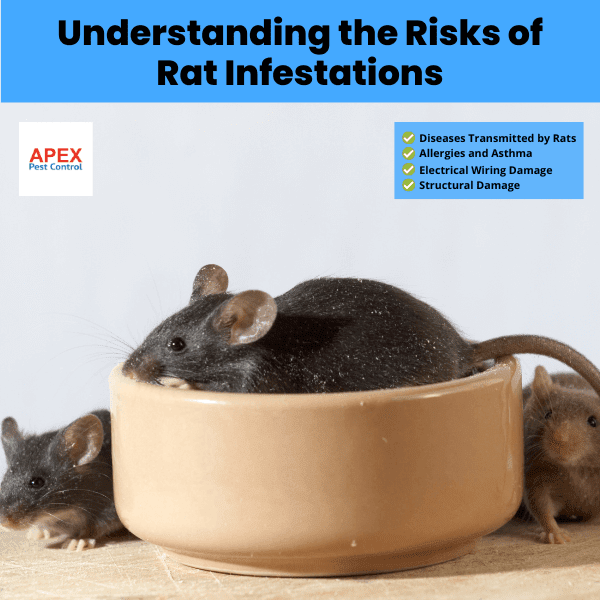
Health Risks
Diseases Transmitted by Rats
There’s no doubt that rodents pose serious health risks to humans due to diseases they carry. Some of these include:
- Hantavirus Pulmonary Syndrome (HPS)
- Leptospirosis
- Salmonellosis
- Rat-bite fever
- Plague
These zoonotic diseases can be transmitted through direct contact with rats, their droppings, urine, or saliva, or through contaminated food and water.
Allergies and Asthma Triggered by Rat Presence
It’s also important to note that allergens found in rat urine can trigger allergies & asthma attacks. The presence of rats in your home can exacerbate respiratory issues, especially in children and elderly individuals.
Property Damage
Structural Damage
Apart from health issues, rats cause property damage too! They’re capable of damaging structures while creating nests & burrows. This could include:
- Gnawing on wooden beams
- Damaging insulation
- Creating holes in walls and floors
Electrical Wiring Damage
Their chewing habit extend to electrical wires, which may lead to fire hazards. This is particularly dangerous as it can cause short circuits and potentially start fires within your walls.
Preventing Rat Infestations
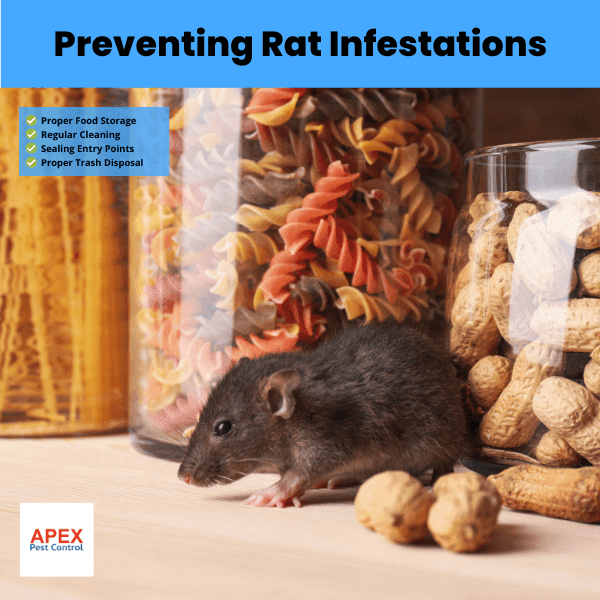
Rat-Proofing Your Home
Sealing Entry Points
To keep rats away, seal cracks & gaps in walls and floors. Also cover vents with fine mesh. Pay special attention to areas where utilities enter your home, as these are common entry points for rats.
Proper Food Storage
Ensure food is stored securely. Using airtight containers helps prevent attracting rats. This includes pet food, which should be stored in sealed containers when not in use.
Regular Cleaning
A clean home can discourage rat infestation by limiting potential hiding places & food sources. Regular vacuuming and decluttering can significantly reduce the attractiveness of your home to rats.
Outdoor Prevention Measures
Maintaining Yard Cleanliness
Clean yards limit potential nesting sites for rats. Regularly remove garden waste and piles of wood. Keep your grass short and remove dense vegetation near your home’s foundation.
Proper Trash Disposal
Dispose of trash properly as it attracts rodents. Use garbage cans with tight-fitting lids to deter them. Consider using metal trash cans, as rats can chew through plastic.
Dealing with Rat Infestations
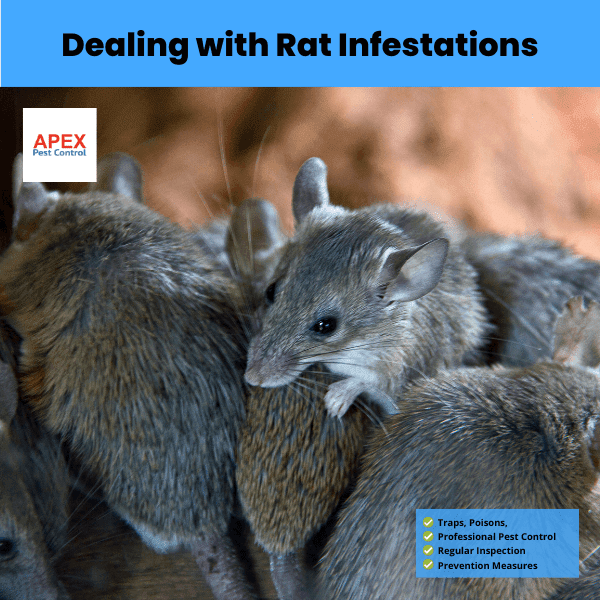
DIY Rat Control Methods
Traps
Setting up traps can help control a small population of rats. Bait the traps using peanut butter or cheese. Place traps along walls and in areas where you’ve noticed rat activity.
Poisons
Using poisons should be your last resort due to their risks towards pets and children if not handled carefully. Always follow manufacturer instructions and consider safer alternatives first.
Professional Pest Control Services
When to Call a Professional
If DIY methods fail or you’re dealing with a large-scale infestation, then it’s time to call professionals who are trained in handling such situations. At Apex Pest Control, we offer expert rat removal services tailored to your specific needs.
What to Expect from a Professional Service
Pest control services inspect your property, set up treatment plans that include monitoring & eliminating the pests, providing long-term solutions. Our team at Apex Pest Control use the latest techniques and environmentally friendly methods to ensure effective rat control.
Maintaining a Rat-Free Environment
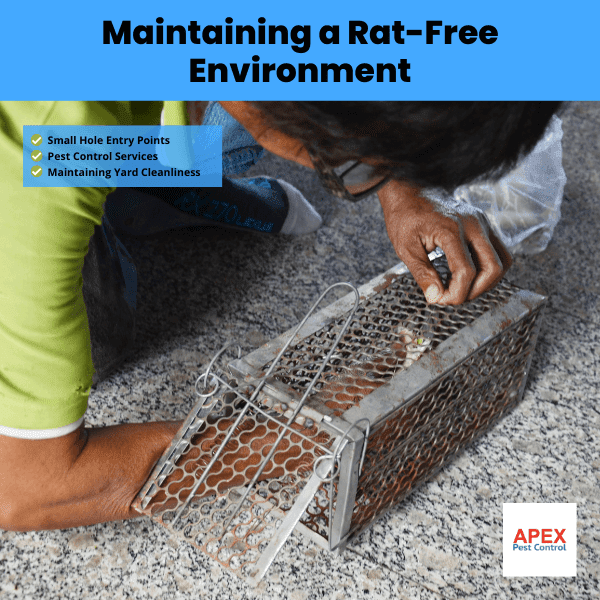
Regular Inspection
Keeping an eye out for signs of rats regularly is key – this includes checking harder-to-reach areas like attics and basements too!
Continuous Prevention Measures
Keep maintaining cleanliness both indoors and outdoors even after getting rid of the initial infestation so they won’t return.
Educating Household Members
Inform everyone at home about the importance of prevention measures – how each person contributes goes far in keeping your environment rat-free!
FAQs
How do I know if there’s a rat infestation in my home?
Look for signs like droppings, gnaw marks, burrows or nesting materials. You might also hear scratching noises or squeaking sounds, especially at night.
What risks do rats pose to humans?
Rats can transmit diseases such as Hantavirus Pulmonary Syndrome and Leptospirosis. They can also trigger allergies and asthma attacks due to allergens in their urine.
How do I prevent rat infestations?
Rat-proof your home by sealing entry points, storing food properly & maintaining regular cleaning. Also maintain yard cleanliness & ensure proper trash disposal.
When should I call a professional pest control service?
If DIY methods don’t work or if you have a large-scale infestation, it’s time to call professionals who are trained to handle these situations.
What measures should be taken after an infestation has been dealt with?
Regularly inspect your property for signs of rats. Continue prevention measures like cleanliness and educate household members on the importance of these actions.
How quickly can a rat infestation grow?
Rat populations can grow rapidly. A female rat can have up to 6 litters per year, with each litter containing 5-12 pups. This means a small problem can quickly become a large infestation if not addressed promptly.
What’s the difference between rat and mouse infestation signs?
While both leave similar signs, rat droppings are larger (about ¾ inch long) compared to mouse droppings (about ¼ inch). Rat gnaw marks are also larger, and rats tend to leave more visible grease marks along walls.
Can rats enter through small holes in walls or foundations?
Yes, rats can squeeze through holes as small as ½ inch in diameter. It’s crucial to seal even small openings to prevent rat entry.
At Apex Pest Control, we’re committed to helping you maintain a rat-free environment. If you suspect a rat infestation or want to take preventive measures, don’t hesitate to contact our expert team. We’re here to provide professional, effective, and environmentally conscious pest control solutions tailored to your needs.

Tony Johnson, Founder & Lead Technician at Apex Pest Control, is a BPCA and NPTA accredited pest management expert with over 35 years’ hands-on experience. Tony specialises in Integrated Pest Management and ensures all services comply with UK pest legislation, including the Wildlife and Countryside Act 1981 and COSHH Regulations 2002. His commitment to continual learning and adapting to industry best practices means clients receive effective, safe solutions for pests affecting homes and businesses across South Yorkshire. Tony’s dedication to professional standards, ethical treatment methods, and local expertise has made him a trusted partner for pest control and prevention.
-
BPCA & NPTA accredited | CHAS certified
-
Committed to UK pest law compliance & safety
-
Focused on effective, ethical pest management for South Yorkshire

